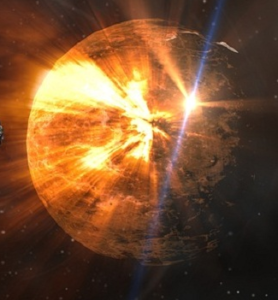
Astronomers claim to have discovered a possible Venus twin, dubbed Kepler-1649b, which is located about 219 light years away from us and orbits a dim star Kepler 1649.
According to scientists, the discovery was made using NASA’s Kepler space telescope. The Venus lookalike is slightly larger than Earth, and complete one orbit around Kepler-1649 in every nine days.
Venus, the planet of love and beauty, is the sixth largest planet in the solar system. It is second planet from the Sun. It is the brightest of all planets in our solar system (when viewed from Earth). Venus is only slightly smaller in size than Earth and has a mass 80% of Earth’s mass. Both planets have craters and also have similar chemical composition and densities. During earlier times, astronomers used to believe that Venus is very much like Earth and could be harboring life. However, later astronomers came to know that Venus is different from Earth in many ways and the least hospitable place for life in the solar system.
“We present the discovery and confirmation of Kepler-1649b, an Earth-sized planet orbiting a nearby M5V star that receives incident flux at a level similar to that of Venus. We present our methods for characterizing the star, using a combination of point-spread function photometry, ground-based spectroscopy, and imaging, to confirm the planetary nature of Kepler-1649b. Planets like Kepler-1649b will be prime candidates for atmospheric and habitability studies in the next generation of space missions,” the authors write in their paper.
According to astronomers, Kepler-1649 is one-fifth the diameter of our Sun. Due to the tight orbit of the Kepler-1649b, the solar flux reaching to this planet is about 2.3 times the solar flux reaching on Earth. Comparitively, the value of solar flux on Venus is 1.9 times the terrestrial value.
Scientists believe that the finding of Kepler 1649b could provide insight into the nature of planets around M dwarf stars—the most common type of stars in the universe.
“While such stars are redder and dimmer than the Sun, recent exoplanet discoveries have revealed instances in which Earth-sized worlds circle an M dwarf in orbits that would place them in their star’s habitable zone. But such worlds might not inevitably resemble Earth, with its salubrious climate. They could just as well be analogs of Venus, with thick atmospheres and scalding temperatures,” the SETI website suggests.
According to SETI Institute scientist Isabel Angelo, the study of planets similar to the Venus analog Kepler 1649b is “becoming increasingly important in order to understand the habitable zone boundaries of M dwarfs.
“There are several factors, like star variability and tidal effects that make these planets different from Earth-sized planets around Sun-like stars.”
Elisa Quintana, from the SETI Institute and NASA Goddard Space Flight Center, and a member of the Kepler 1649b discovery team, notes that “Many people are hung up on finding other Earths. But Venus analogs are just as important.
“Since new telescopes coming down the pike will allow us to probe atmospheres, focusing on both Earth and Venus analogs may help decipher why, in our Solar System, one planet allows life to thrive, and one does not, despite having similar masses, comparable densities, etc.”
The detailed findings of the study have been published in AstroNOMICAL Journal.

